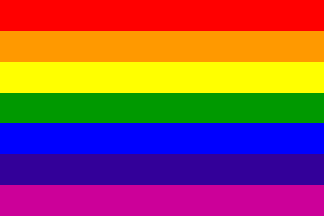
Last modified: 2003-02-01 by antonio martins
Keywords: rainbow flag | gay pride | baker (gilbert) | steve (tyson) | international congress of flag makers | flag of the race | stripes: 8 | stripes: 7 | stripes: 6 | stripes: 5 |
Links: FOTW homepage |
search |
disclaimer and copyright |
write us |
mirrors

The first Rainbow Flag was designed in 1978 by Gilbert
Baker, a San Francisco artist, who created the flag in
response to a local activist’s call for the need of a
community symbol. (This was before the pink triangle was
popularly used as a symbol of pride.) Using the five-striped
“Flag of the Race” as his inspiration,
Baker designed a flag with eight stripes. Baker dyed and
sewed the material for the first flag himself — in the true
spirit of Betsy Ross.
Christopher Pinette, 12 Jun 1996
The design may have been influenced
by flags with multicolored stripes
used by various left-wing causes and
organizations in the San Francisco
area in the 1960s. The Rainbow Flag
originally had eight stripes (from top
to bottom: hot pink for sex,
red for life, orange for
healing, yellow for sun,
green for serenity with nature,
turquoise for art, indigo for
harmony, and violet for spirit).
Handmade versions of this flag were flown
in the 1978 Gay Freedom Day Parade.
Steve Kramer, 24 April 1998

After the November 1978 assassination of San
Francisco Mayor George Moscone and openly gay
Supervisor Harvey Milk and the subsequent lenient
sentence given to their killer, former Supervisor
Dan White, the Rainbow Flag began to be used in
San Francisco as a general symbol of the gay
community. San Francisco-based Paramount Flag Co.
began selling seven-striped (top to bottom: red,
orange, yellow, green, blue, indigo, and violet)
flags from its Polk Street retail store, which
was located in a large gay neighborhood. These
flags were surplus stock which had originally
been made for the the International Order of
Rainbow for Girls, a Masonic organization for
young women. When Baker approached Paramount to
make flags for the 1979 Gay Freedom Day Parade,
Paramount informed Baker that fabric for hot
pink was not available for mass production, and
Baker dropped the hot pink stripe.
Steve Kramer, 24 April 1998

Baker also asked Paramount to make vertical banners
that would be split and displayed from the angular double
bars of the old-style lamp posts on Market Street. Baker
and Paramount’s vice president Ken Hughes agreed to drop
the hot pink and turquoise stripes and
replace the indigo stripe with royal blue
— resulting in three stripes on one side of the lamp post
and three on the other.
Steve Kramer, 24 April 1998
Soon the six colors were
incorporated into a six-striped version that became
popularized and that, today, is recognized by the
International Congress of Flag Makers.
Christopher Pinette, 12 Jun 1996
Regarding the gay pride rainbow flag there was a good
article in the Flag Bulletin
[tfb] some years ago that gave
a long history of rainbow flags and their use as a symbol
of hope for difficult causes. At the
NAVA conference in Sacramento,
Steve Tyson, a former
employee of the former flag company, Paramount Flag Co.,
in San Francisco presented a lecture on the origins of this
particular flag. Apparently, he had taken remnants, scraps
of flag material and gone to the production department to
make decorative flags to use up the scrap material. He
showed several variations. The horizontal stripes (with
white in the center) become popular. The company chose
to produce it (without the white stripe) and from there
it was adopted as a gay pride flag.
I am not familiar with the actual procedure of the
adoption by the gay community although I think Mr. Tyson
did make some reference to that.
Herold Lee, 08 Jan 1998
There is no “International Congress of Flag Makers”
that “recognizes” flags. This is a suppositious organization.
It has never existed. We see it often in association with the
Rainbow Flag in San Francisco. What this is a contraction of
two names, the English version of FIAV,
or the International Association of Vexillological Associations,
and Flag Congress. The term Flag Congress was the meeting name
of the joint meetings FIAV XII and NAVA
XXI, held in San Francisco, CA in the Summer of 1987. The largest
such meeting ever held, hosting over 150 vexillologists from
16 nations. The “International Congress of Flag Makers” was
inadvertently created by Gilbert Baker when he was interviewed
by the representatives of the Gay press in San Francisco,
during Flag Congress. During that interview Mr. Baker confused
the organization FIAV and the event Flag Congress. The result
was this supposed organization. By "recognition" he was in fact
referring to the paper I presented at Flag Congress entitled
“The Evolution and Adoption of the Rainbow Flag in San Francisco”,
in which the full details of the Rainbow Flag are chronicled.
It was published in The Flag Bulletin
[tfb]
XXVIII: 1-4/130: 116-122.
James Ferrigan, 25 Mar 1999
What’s this “five-striped Flag of the Race”, which
supposedly inspired the gay rainbow flag?... The only
such flag I know, la bandera
de la raza, shows three purple crosses and a
sun — no stripes at all...
António Martins, 20 Apr 1999